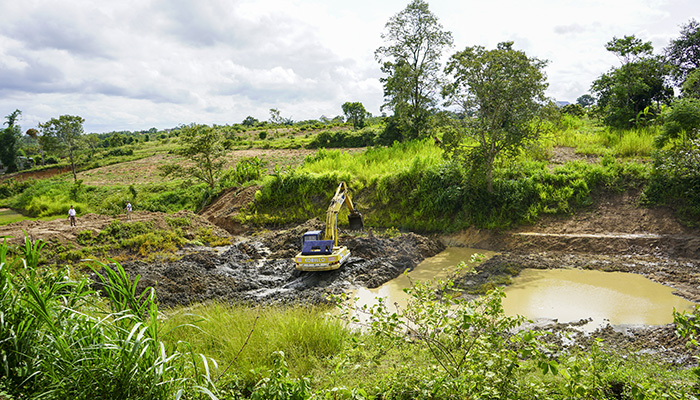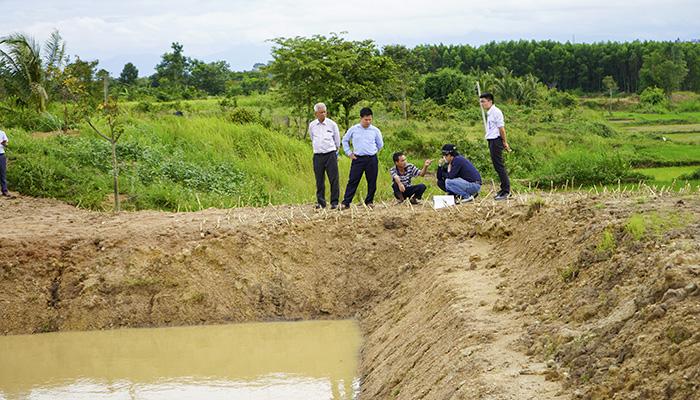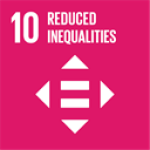
Mr. Long is eager to maintain the large common pond which supports him and other five families. Photo: UNDP
Like many other farmers in the district of Ea Kar in Dak Lak province, Mr. Luc Van Long and Ms. To Thi Van have struggled in the face of water scarcity and annual droughts.
Each time their crops have died, they have looked to the skies and pleaded for rain.
"While there are good rains now, there is ongoing drought. Before this, it had been dry for months – we dug a 100-metre well, but there was no water. Our crop rates dropped by 30 to 40 percent," Long said. "Our fruit trees were left thirsty, and we had less food on the table. The economic effects were also bad, hurting our income and our families’ well-being."
"For years, drought has been our unwelcome companion. We feel helpless,” Van shared. “Our crops suffer, and we suffer too. In such unforgiving conditions, I have fought hard to keep our cherished fruit trees alive. It was heartbreaking to watch them wither."
"I do not know what to do – all I can do is wait for the rain…Farmers do not know any better way to cope with water shortages."
Their lives, however, were about to change dramatically with the construction of climate-resilient ponds, built under a government-led project strengthening the resilience of smallholder agriculture to climate change-induced water insecurity in the Central Highlands and South-Central Coast regions of the country.

Pond under construction.
Implemented by the Ministry of Agriculture and Rural Affairs, with the support of the UN Development Programme and People's Committees in the five provinces of Dak Lak, Dak Nong, Khanh Hoa, Ninh Thuan, and Binh Thuan – and made possible with finance from the global Green Climate Fund – the project (known as SACCR) has been working to empower vulnerable smallholder farmers to manage increasing climate risks.
The ponds integrate innovative features to minimize water loss and avoid sedimentation. Nature-based solutions, for example planting locally suitable plants (vetiver grass, bamboo) and trees around the edges of ponds, make them more resilient to climate-related impacts such as erosion and evaporation.
The completion of 130 ponds have given hope to farmers like Long and Van. Each stores rainwater and surface water and offers a reliable source of water during the annual dry season.

To construct the ponds, irrigation experts used rainfall modeling to calculate water balance, considering multiple factors such as the maximum use of available water resources, geographical conditions, climate risks, and traditional local experiences.
Both Van and Long play an active role in the project’s implementation. Long joined a "pond management group" that handled its building, operation, and maintenance. "The pond serves five homes, and we all help to keep them well-maintained, including checking for erosion of its banks, and dredging the pipes which carry water to the pond. We now have hope that things will get better."
The ponds have had a significant effect. With steady access to another water source, Van replanted her favorite fruit trees and plants. She joyfully replanted her cherished litchi trees and perennials. "Since having another source of water, I feel motivated to develop. I thank the authority departments and the project for supporting my family," she said, smiling.
"The climate-resilient ponds have become our lifeline, bringing much-needed water to our crops," Long said.
Ms. Ramla Khalidi, UNDP Resident Representative in Viet Nam, praised the new ponds, saying, "These ponds, a key outcome of our project, represent the power of innovation and community engagement in addressing water scarcity challenges in harmony with nature. Each pond becomes a symbol of hope, offering farmers like Mr. Luc Van Long and Ms. To Thi Van a lifeline to safeguard their livelihoods against the challenges of climate change. The journey ahead holds great promise, with the potential to create a more resilient and prosperous future for all, reflecting the heart of our mission at UNDP."
Mr. Nguyen Manh Ngoc, SACCR Project Manager was also pleased to see these initial results, “The ponds contribute to improving farmers' resilience to water scarcity, a critical task of the agriculture sector and the Ministry. With the support of the Green Climate Fund, and UNDP, the project activities are comprehensively designed, and community participation brings maximum benefits to the local people. The results of the construction of climate-resilient ponds as part of the project's activities will demonstrate the power of collaborative efforts and innovative solutions in mitigating the impacts of climate change. We will continue to accompany and commit to strengthening sustainable development and protecting livelihoods for rural communities in the Central Highlands, South Central Coast, and other localities of Viet Nam."
In the face of climate change-induced adversities, the simple but innovative solution of constructing climate-resilient ponds are inspiring farmers to see a brighter, more secure, and sustainable future. They provide a beacon of hope, illuminating the path towards a world where communities flourish, crops thrive, and nature too benefits.




